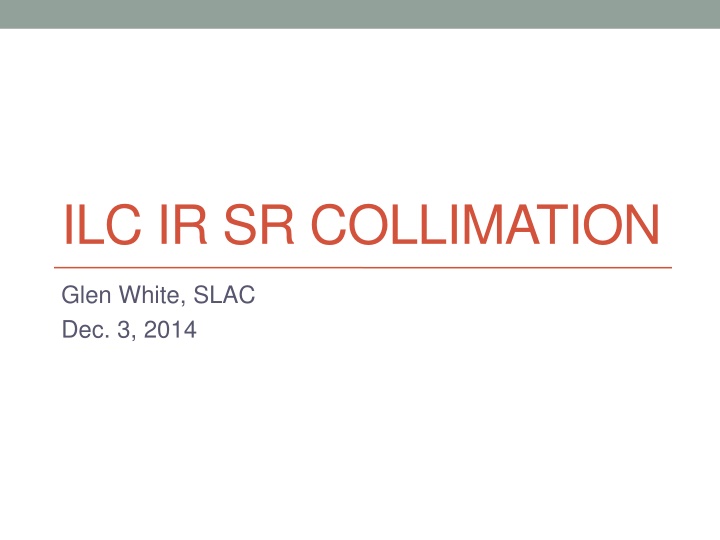
ILC Collimation Overview and Solutions for Suppressing IR SR Hits
Explore the detailed process and solutions proposed by Glen White at SLAC in December 2014 for eliminating IR SR hits in the ILC collimation system. The discussion includes the implementation of an IR solenoid field, tracking simulations, dynamic aperture analysis, halo loss rates, collimation requirements, and more to optimize the performance and protection of the system.
Download Presentation

Please find below an Image/Link to download the presentation.
The content on the website is provided AS IS for your information and personal use only. It may not be sold, licensed, or shared on other websites without obtaining consent from the author. If you encounter any issues during the download, it is possible that the publisher has removed the file from their server.
You are allowed to download the files provided on this website for personal or commercial use, subject to the condition that they are used lawfully. All files are the property of their respective owners.
The content on the website is provided AS IS for your information and personal use only. It may not be sold, licensed, or shared on other websites without obtaining consent from the author.
E N D
Presentation Transcript
ILC IR SR COLLIMATION Glen White, SLAC Dec. 3, 2014
1 3/20/2025 ILC Collimation - GRW Overview Find collimation solution required to eliminate IR SR hits FFS L*=4m, EXT L*=5.95m ECM= 500 GeV Tail-folding octupoles OFF Include IR solenoid field map Using Lucretia macro-particle tracking with GEANT4 for solenoid field tracking Solenoid Field Region QF1 QD0 QDEX1 QFEX2A
2 3/20/2025 ILC Collimation - GRW Add IR Solenoid Field to Tracking Simulation 5T Solenoid field implemented (SiD) Shown longitudinal and radial B field component as a function of z (symmetry assumed) on- solenoid-axis (blue) and at +/- 5cm radially (red). Beam tracked through field according to crossing angle (14mrad / 2) Tracking through the solenoid field region done by GEANT4 (including SR) using above field map overlaid on to quad field maps. Add dipole fields to quads to steer reference orbit flat through solenoid.
3 3/20/2025 ILC Collimation - GRW Initial 5D Phase-Space for tracking given by Dynamic Aperture @ QF1 E +/- 1% Nmacro ~ 1E6
4 3/20/2025 ILC Collimation - GRW Sample of Resulting SR Rays in IR
5 3/20/2025 ILC Collimation - GRW Collimation Required to Suppress SR Hits to Apertures +/- 50m (z) from IP 0 Hits Contour -> SP2/SP4 Spoiler Y = 0.4mm (50 ) % Initial Halo e- s generating IR SR Hits SPEX Spoiler X = 1.6mm ( E +/- 1%)
6 3/20/2025 ILC Collimation - GRW Halo Loss Rate in Magnets FFS (No Collimation) 6.2 Represent beam halo as 0.1% main beam charge (intercepting) with 1/r profile in transverse dimensions and 1% dP/P (Gaussian distribution). Calculate max loss rate in magnets from tracking simulation (107 MP) Loss rate for magnets as a function of horizontal SP2/4 collimator aperture Fix vertical @ 50 Primary collimation <1W/m pk loss @ 6.2
7 3/20/2025 ILC Collimation - GRW Summary Suggested collimation requirements shown for L*=4m BDS optics. 6.2 x 50 collimation @ COLL spoilers required (0.6 x 0.2mm @ SP2/4) based on requirement of no allowed SR photon hits +/- 50m of IR & magnet halo protection cf. TDR specification: 6-9 x 40-60 Still to check: Updated IR fields, ILD field map Collimation performance with secondary particle production Expected muon fluxes Collimator wakes Tail-folding octupoles Realistic optics errors & misalignments Systematic error study of simulation
